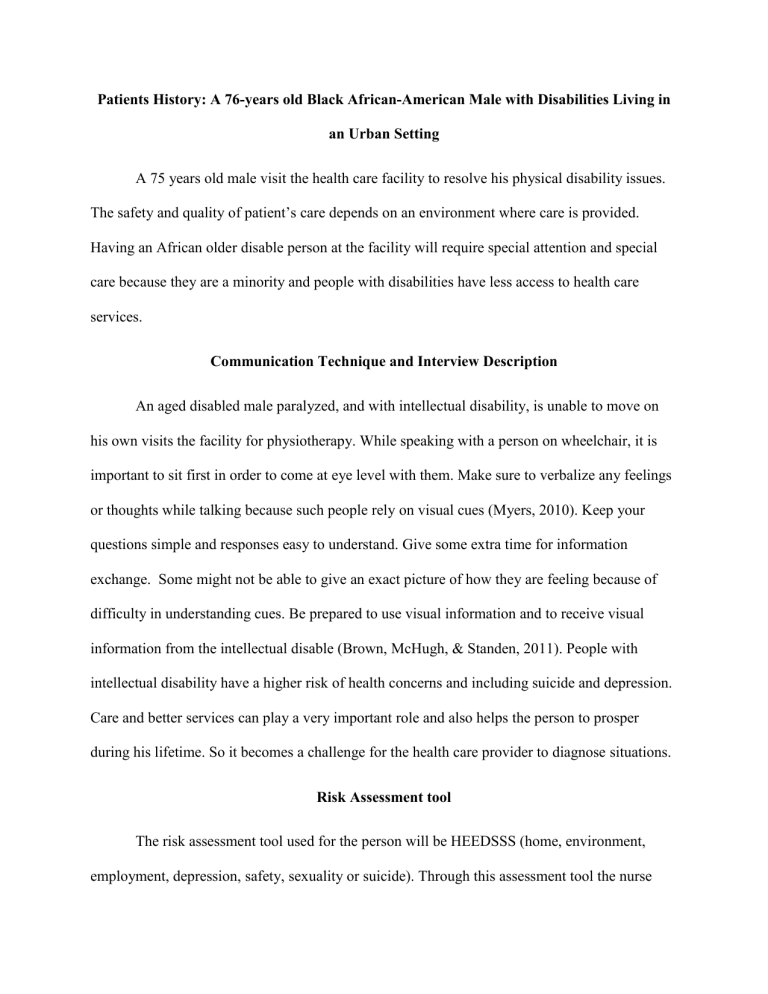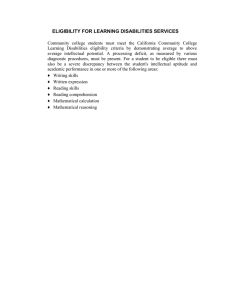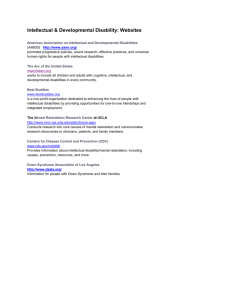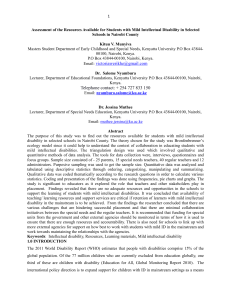
Patients History: A 76-years old Black African-American Male with Disabilities Living in an Urban Setting A 75 years old male visit the health care facility to resolve his physical disability issues. The safety and quality of patient’s care depends on an environment where care is provided. Having an African older disable person at the facility will require special attention and special care because they are a minority and people with disabilities have less access to health care services. Communication Technique and Interview Description An aged disabled male paralyzed, and with intellectual disability, is unable to move on his own visits the facility for physiotherapy. While speaking with a person on wheelchair, it is important to sit first in order to come at eye level with them. Make sure to verbalize any feelings or thoughts while talking because such people rely on visual cues (Myers, 2010). Keep your questions simple and responses easy to understand. Give some extra time for information exchange. Some might not be able to give an exact picture of how they are feeling because of difficulty in understanding cues. Be prepared to use visual information and to receive visual information from the intellectual disable (Brown, McHugh, & Standen, 2011). People with intellectual disability have a higher risk of health concerns and including suicide and depression. Care and better services can play a very important role and also helps the person to prosper during his lifetime. So it becomes a challenge for the health care provider to diagnose situations. Risk Assessment tool The risk assessment tool used for the person will be HEEDSSS (home, environment, employment, depression, safety, sexuality or suicide). Through this assessment tool the nurse will be able to analyze the patient’s current situation, how is he managing at home, financial support, and how he is dealing with stress or depression. Treating an aged person is a challenge for the health care provider. They also need support from their families. Challenging behavior occur in patients, they are aggressive most of the times. Extra care and attention is require in dealing with such challenges. Questions to be asked Targeted question for the patients will be: 1. In the past week, how much of physical activity you have done that increases your heart beat? 2. Did you need help from anyone in the past 5 year to perform your everyday activates (such as eating, bathing, walking or taking medicines) 3. Have you ever been treated by a psychologist? 4. Who are you staying with? Does your family support you? 5. Over the past week how many times you feel depressed or hopeless? Through following questions doctor will be able to gather information about the patient and will treat him accordingly. It is very important to get information about the patient before treatment. People with intellectual disability are socially isolated, they are not allowed to build friendships or sexual relations (Emerson, 2001). The only relationship they have is with their staff or care provider (Singh, Lancioni, & Winton, 2009). References Brown, D. J., McHugh, D., & Standen, P. (2011). Designing location-based learning experiences for people with intellectual disabilities and additional sensory impairments. Computers & Education,, 56(1), 11-20. Emerson, E. (2001). Challenging behaviour: Analysis and intervention in people with severe intellectual disabilities. England: Cambridge University Press. Myers, K. A. (2010). Understanding communication preferences of college students with visual disabilities. Journal of College Student Development,, 265-278. Singh, N. N., Lancioni, G. E., & Winton, A. S. (2009). Mindful staff can reduce the use of physical restraints when providing care to individuals with intellectual disabilities. Journal of Applied Research in Intellectual Disabilities,, 22(2), 194-202.




